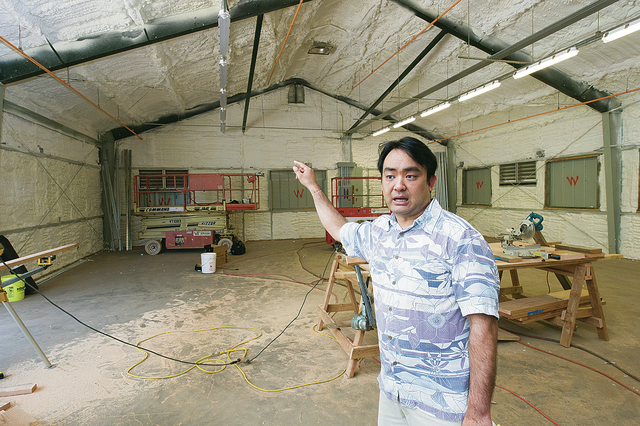Emergency homelessness proclamation extended

CRAIG T. KOJIMA / AUG. 2
Scott Morishige, state homeless coordinator, inspects a homeless shelter that is being converted from a maintenance shed behind the John A. Burns School of Medicine in Kakaako. Morishige said Gov. David Ige’s proclamations have benefited 13 homeless-related projects and that more are in the works.
Gov. David Ige on Thursday extended his original 2015 emergency proclamation on homelessness for the sixth time to more quickly bring homeless projects online — and officials in California are taking notice, Hawaii’s homeless coordinator said.
Scott Morishige said in a Thursday interview that officials from some California counties — including Los Angeles County — got on a conference call with his office Wednesday and “expressed interest in our proclamations. We’re doing a lot of things that are innovative that directly impact homelessness.”
But Morishige said Ige’s administration understands that it needs to pivot from an emergency response on homelessness “to a longer-term approach” that continues to focus on developing affordable housing, health and human services, and public safety.
“We had such a crisis situation that we knew we had to respond quickly,” he said.
The so-called “supplemental” proclamation, which Ige signed Thursday, extends his original October 2015 proclamation for an additional 60 days, until Oct. 19, which allows state and county officials to waive normal contract bidding rules and even union contracts, if necessary, according to a news release issued Thursday by Ige’s office.
In the interview at the Honolulu Star-Advertiser’s offices, Morishige ran through the list of 13 homeless-related projects that have benefited from the proclamations, and hinted that more could come online soon, including a possible expansion of the city’s nascent Hale Mauliola community on Sand Island, which has taken in 214 homeless people since it opened in November.
Don't miss out on what's happening!
Stay in touch with breaking news, as it happens, conveniently in your email inbox. It's FREE!
Since Ige signed his original homeless proclamation in October, Morishige said, they have helped more than 4,800 people — including 1,353 island families — either find homes or prevent them from becoming homeless.
Specifically, Morishige said, Ige’s proclamations have helped dramatically reduce the size of the Kakaako homeless encampment from more than 300 people last summer to somewhere between 30 and 50 homeless people per night.
Seven of the nine homeless projects that require construction are on Oahu, and six are being built through the City and County of Honolulu. They’ll begin housing homeless people four to five years ahead of the time it takes to build or renovate a normal government project, Morishige said.
Collectively they expect to directly house 500 homeless people and a still-to-be-determined number of low-income residents, Morishige said.
But the proclamations have helped homeless-related efforts far beyond building or renovating housing, Morishige said.
When the federal department of Housing and Urban Development this year cut funding for seven local nonprofit organizations that provide transitional housing, the proclamations helped provide emergency funding to keep about 300 clients from becoming homeless again, Ige’s office said.
The proclamations also enabled the state Department of Human Services to sign a contract with Aloha United Way to quickly disperse $4.7 million of state money to homeless families — and those at risk of becoming homeless — instead of putting the contract out to bid.
At the same time, Morishige said, the state Department of Human Services helped develop “a new model of contracting” that allows the AUW to serve as the master contractor in charge of social service programs on all islands to get the money out to families in need.
“How often do you see government moving quickly in multiple areas and showing real, tangible results?” Morishige asked. “The proclamations have allowed us to move on all fronts.”
4 responses to “Emergency homelessness proclamation extended”
Leave a Reply
You must be logged in to post a comment.




“they have helped more than 4,800 people — including 1,353 island families — either find homes or prevent them from becoming homeless.” – Of these “provide emergency funding to keep about 300 clients from becoming homeless again”. How many more homeless are out there?
The homeless that won’t go to shelters and provided housing should be given citations. Then, if they don;’t pay the fines and are back on the streets, put them in jail.
Morishige seems to be a right on guy. Who else besides Senator Tom Brower is willing to handle the homeless problem? Isn’t he the one who helped the gays get marriage legitimacy in Hawaii? All you LBGT had better help this young man with campaign contributions and footwork. He deserves your support.
Basically, the state is conducting a holding action and the number of homeless will increase because the cause is economic and the absence of low income housing.
In addition with the migration of people from Micronesia this just adds to the problem for which the local tax payer is left holding the bag to provide for these people who are ill equipped
to deal with the highest cost of living in the US. These migrants may be smarter to move on to the mainland where the opportunities are better. Otherwise, many of them will end up being
on the bottom of the social order here and a permanent dependent class much like blacks in our large inner cities on the mainland.
How long does an emergency last? Sounds like the City’s 90-day hires that keep getting renewed time after time.